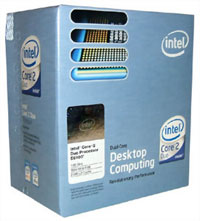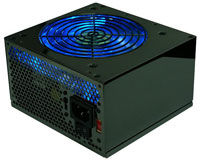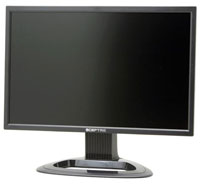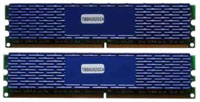Upgraded Midrange Configuration
We've covered our basic recommendations, but of course there's a lot of fine tuning that can be done. The price bracket that can be defined as being midrange is pretty large; some people feel midrange is closer to $1000 while others feel it's closer to $2000. We would say $2000 is more of a high-end configuration, but as we mentioned earlier you don't need to purchase every upgraded component when customizing your own midrange build. Here then are the upgraded midrange recommendations.
| Intel Mid-Range Performance System |
| Hardware |
Component |
Price |
Rebates |
| Processor |
Intel Core 2 Duo E6600 (2.40GHz 4MB Shared) - Retail |
$317 |
|
| Motherboard |
ASUS P5B-E (P965 775) |
$151 |
|
| Memory |
Super Talent 2x1GB DDR2-800 (T800UX2GC4) |
$268 |
|
| Video Card |
Sapphire Radeon X1950XT 256MB (100186L) |
$256 |
$30 |
| Hard Drive |
Western Digital 500GB SATA 3.0Gbps 7200RPM 16MB (Caviar SE16) |
$148 |
|
| Optical Drive |
LG Black 18X DVD+R (GSAH22N-BK) |
$36 |
|
| Case |
Lian Li PC-7B plus II |
$103 |
|
| Power Supply |
Rosewill SLI 600W (RP600V2-S-SL) |
$73 |
|
| Display |
Sceptre x22wg-Gamer 22" 5ms DVI+HDMI (1680x1050) |
$365 |
$20 |
| Sound Card |
Creative Sound Blaster X-Fi XtremeGamer 7.1 |
96 |
|
| Speakers |
Logitech Z-5300e 5.1 280W THX Speakers |
$159 |
|
| Keyboard and Mouse |
Microsoft Comfort Curve 2000 B2L-00047 |
$28 |
|
| Operating System |
Windows XP MCE 2005 (with Vista coupon) |
$115 |
|
| Bottom Line |
|
$2115 |
$2065 |
 |
As you can see, we've limited our performance upgrade to the Intel platform. AMD is still be reasonably competitive with the E6600 when using their X2 5000+, but we definitely give the edge to Intel and the prices of those two processors are about the same. A few of the less critical components stayed the same, but we've upgraded almost everything.
The upgraded processor improves clock speed over the E6300 by 28%, and the 4MB L2 cache typically adds another 5% to 15% performance depending on the application. It ends up being about 40% more processor performance for a price increase of 70%, which really isn't that bad in terms of CPU price/performance scaling.
The ASUS P5B-E motherboard isn't going to be noticeably faster than the Biostar 965PT, but it does have some extra features. The ASUS board adds FireWire support, three more internal SATA ports and one eSATA port, RAID 0/1/5/10 support, a slightly different expansion card slot arrangement, and a different onboard audio solution. The ASUS P5B-E is also one of the better overclocking motherboards, especially in its price bracket.
Along with the faster processor and upgraded motherboard, we selected some Super Talent DDR2-800 memory with 4-4-3 timings. The performance benefit of the faster memory probably isn't worth the extra $40 ($70 after OCZ rebate) unless you plan on overclocking, and we will be using this same memory on the overclocking configuration. These Super Talent DIMMs allow for up to 2.2V officially and should come close to matching the performance of many of the $400+ memory kits. Timings will likely need to be relaxed a bit more, but overall they are very good DIMMs.
 |
There are quite a few good graphics cards in the $200-$300 price range, and for the performance configuration we selected one of the faster models. The X1950 XT 256MB is nearly as fast as the full X1950 XTX in most situations, but it's priced about $100 lower. There are a few games and applications that can benefit from having 512MB of memory, but even then the performance difference is rarely more than 10% so the 40% price increase is hard to justify. Anyone interested in running a CrossFire setup would need to choose a different graphics card, as there are no 256MB X1950 XT CrossFire cards right now, but we wouldn't recommend CrossFire or SLI as a reasonable gaming solution unless you are already running at least a GeForce 8800 GTS or faster graphics card.
 |
The hard drive, power supply, and display upgrades all take the same approach: bigger is better! If you're not the type of person to fill even a 250GB hard drive, obviously the hard drive upgrade is unnecessary. The Rosewill 600W power supply is probably overkill, but users who plan on adding multiple hard drives and perhaps a second graphics card in the future probably won't feel too bad about spending an extra $10. Whether or not the Rosewill 600W is really that much better than the Fortron Source 450W is debatable, but most people have been pretty pleased with the midrange Rosewill offerings. Just be aware that they aren't particularly quiet.
 |
The 22" LCD has the same resolution as the 20" LCD in our base configuration, but it does have a few other advantages. The Sceptre x22wg-Gamer boasts a 5ms response time (versus 8ms), but more importantly it includes HDCP support and it also has an HDMI input. Acer offers a couple of similar 22" LCDs that are worth considering, and if you are primarily concerned with image quality we would rate them as being more or less equivalent to the Sceptre (most of the 22" LCDs use the same panel after all). For $50 less you can forget all about HDCP support and just get a standard LCD, or you can save $20 and still get HDCP but drop the HDMI port. Several other companies offer similar LCDs, with prices ranging from $300-$400, but if you want to get something larger than a 22" LCD the next step up will be the 23" and 24" models that cost at least twice as much. We'll save such displays for the High-End Buyer's Guides.
 |
The last two upgrades are a change of case and improved audio, neither of which are truly a critical upgrade. The Lian Li cases do look nice and they are invariably very high-quality designs, and the PC-7B Plus II has been popular for quite some time. Unlike the basic case, the Lian Li features an aluminum construction that reduces the weight and helps to avoid sharp edges on the interior. It also comes with two 120mm fans which should help to provide exceptional cooling for all but the most demanding builds. The drawback of the two fans is that they do tend to create more wind noise, but you can always unplug the front fan if that's a concern.
 |
As for the speakers, the Logitech Z-5300e speakers certainly sound better than the cheaper Logitech X-530, but they also take up more space. The subwoofer in particular is very large (as is the remote), and for many environments the sound output may be overpowering. There's also no point in investing in really nice speakers if you don't intend to use a higher-quality soundcard, which is why we've included the Creative Sound Blaster X-Fi XtremeGamer. The X-Fi will primarily help in gaming applications, but it does provide cleaner audio than onboard solutions as well. Multimedia enthusiasts might also be interested in adding a TV tuner card, in which case we would look towards either the NVIDIA DualTV, ATI Theater 650, or one of the Hauppauge offerings.
Altogether, the various performance upgrades add almost $800 to the total cost. We do feel that every one of the upgrades is justifiable, but most people probably aren't looking to spend upwards of $2000 on a new computer. This is definitely a high-end configuration rather than a midrange system, but we wanted to give a list of good potential upgrades without drifting off into long-winded debates about which upgrades are the most important. If you want a good start to a high-end computer, you can of course take this list and run with it you will be very pleased. If you want more of a middle ground, the speaker, case, motherboard, and memory upgrades are the first areas we would look to trim costs.


















43 Comments
View All Comments
vailr - Friday, January 19, 2007 - link
Intel doesn't offer any compelling single core solutions right now.Consider the socket 775 Celeron D 356. When compared with an older Northwood P4 CPU of similar speed [~3.3 GHz at stock speed], it would seem to be a very good price/performance ratio upgrade. Tiger Direct has it for $50, after a $20 MIR. Combine with a VIA chip based motherboard, such as the ASRock Dual-VSTA or ECS P4M800 (or similar VIA board), which can also still re-use older DDR memory sticks and AGP video cards. Might even make an interesting basis for an Anandtech review, showing the "best bang for buck" upgrades, for a 2 or 3 year old system.
Some Celeron D 356 owners have also had excellent overclocking results (past 4 GHz), depending on the motherboard used.
mino - Saturday, January 20, 2007 - link
When compared with an older Northwood P4 CPUWell, the problem is A64 3200+ goes for $60.
$5 cheaper than 356...
LoneWolf15 - Friday, January 19, 2007 - link
At which resolutions? At 1920x1200, I think the 8800GTS would be the clear winner.
Also, I'd be interested to know how much difference there is between the Creative X-Fi ExtremeGamer, and the similarly priced (well, compared to your review, online I've seen it retailing slightly higher) X-Fi ExtremeAudio. The ExtremeAudio has the nicer gold-plated jacks; the ExtremeGamer actually is the first Creative card that I've seen that allows a user to plug in standard Intel-spec front panel audio. The card layouts are so different that I'm sure there has to be more differences than that; I'd like to know what those are.
uofahoefx - Friday, January 19, 2007 - link
If you are comparing price/performance I think the X2 4200+ would have been a better starting point. The performance difference between the 3800+ and E6300 is too significant to compare these systems.KorruptioN - Friday, January 19, 2007 - link
Whether or not the Rosewill 600W is really that much better than the Fotron Source 450W is debatableIt really is. I did some research as to who really was the OEM for this particular 600W Rosewill, and it turns out that the OEM is Solytech (the UL label on the PSU says E223918, Googling that brings me to http://www.jonnyguru.com/SMPS_UL.htm">this list, which then tells me Solytech). These guys are the new image for Deer electronics. If you've been around the hardware world for a while, you might know that Deer PSUs a few years back were notorious for being fire hazards, nothing better than doorstops. I still wouldn't trust them today. I think it was a poor choice for your guide.
For $71, you can get a much better PSU. Antec's http://www.newegg.com/Product/Product.asp?Item=N82...">TP3-430 is a good choice, and you'd be saving money. It's a Seasonic build, so you can be assured of high-efficiency, low-noise, and good power.
Operandi - Friday, January 19, 2007 - link
Your right Rosewill sucks. This guide would have been better served having recommended the entry level 450 watt Forton across the board since nothing here would be able to break 300 watts DC let alone 600 (assuming the Rosewill could even reach that point which itself is doubtful).About the Antec TP3; it is built buy Seasonic but it has also had corners cut to reach that price point -- it is not equal to Seasonic's own units. If you want Seasonic build quality get a Seasonic (or PCP&C Silencer or Crucial) if you want the best PSU to $$$ ratio it has to be this 400 watt http://www.ewiz.com/detail.php?name=PS-E5140GH">Enhance.
JarredWalton - Friday, January 19, 2007 - link
Despite the hard stance a lot of "informed enthusiasts" take on Rosewill, actual testing of a 500W unit by http://www.jonnyguru.com/review_details.php?id=48">JohnnyGuru.com turned in very favorable results. This is the same site that disliked the high ripple on the OCZ GameXStream 700W, FWIW (but still gave it a good review). I continue to think people are judging Rosewill without having actually tested/used any of their products. Are their QC standards as high as SeaSonic or some of the other top brands? Probably not, but outside of perhaps higher than normal DOA parts (which you just send back and get a new, working unit), they work very well in our experience.yyrkoon - Sunday, January 21, 2007 - link
Now, it is not the one being talked about here, but just yesterday, another IT friend of mine, got in his new thermaltake water cooled system case, and used a 350W Rosewill PSU to power up the water cooling portion (thankfully for him, his system board hadn't arrived yet), and while testing the cooling system a loud *pop* came from the the PSU, followed by a small 'billow' of smoke( he thinks he probably blew the top of a capacitor off, but didn't bother to look). The PSU continued to work for another 15 minutes according to him, but who knows what would have happened if this was powering a full system.Yeah, a 350W PSU, would not be powering an i680 system board, with a E6600, and dual 8800GTX's (which will be his finished system), but this speaks a lot for the manufacturer IMHO. Also, I've rarely seen a PSU take out more than just itself when dying, but it does happen. In my buddies case here, he intends on this system lasting him another 4-5 years, so, having an in-expencive PSU in the mix is not an option. One last thing, JonnyGuru mentions himself, that even while the Rosewill PSU in question does perform admirably, the choice of capacitors use in it, is questionable. Anyone who has been building systems for a awhile must realize that when components die in a computer system, there is a very good chance, it is because of the caps used on one component, or another, be it system board, or PSU. I myself am a big fan of ABIT, and even have had a system board from them die after 5-6 years, because of leaking / bad caps . . .
mostlyprudent - Saturday, January 20, 2007 - link
I have been personally very disappointed with my Rosewill PSU. I bought a 400W version about a year ago to replace the generic 350W that came with the case I used for the general family PC. The Rosewill is louder and less stable. I had recently bought an Fortron Source 380W for my office PC for a few $ more than the Rosewill and have been extremely pleased.Just thought I'd share my personal experience for what it is worth.
yyrkoon - Friday, January 19, 2007 - link
DO you seriously think any reseller / system integrator would recommend such a PSU ? I wouldn't. Anyone can make sly connotations one way, or another, but the simple fact is, we here have a reputation to uphold when building systems for 2nd parties, and would NEVER recommend such a PSU. Now if a customers wishes to shave costs by buying 'lesser' components, we just make sure they're informed of the possibilities, and leave it at that. It is not like every single 'cheap' PSU is garbage, most work fine, it is the ones you don't know about that creep up and bite you in the ass.
Another way to look at it is, you just dropped $1000 on a system, that will hopefully last at least a couple of years, whats another $100-$200 on a good, proven PSU? Perhaps if your computer means very little to *you* there is no harm done, when and if if fails, but I personally like the assurance that whatever I buy will be the best for the amount of money I've spent, and simply put, none of those parts would be made by Rosewill. An external USB HDD case ? sure, ok, fine, but never a PSU.